Effects of Agricultural Machinery Operations on PM2.5, PM10 and TSP in Farmland under Different Tillage Patterns
Abstract
1. Introduction
2. Materials and Methods
2.1. Field Site
2.2. Experimental Design
2.3. Test Indexes and Methods
2.3.1. Dust Concentration Measurement
2.3.2. Calculation of Dust Mass
2.4. Data Processing
3. Results
3.1. Comparison of Dust Concentration under Different Agricultural Machinery Operations
3.2. Differences in Dust Concentration Caused by Agricultural Machinery Operations at Different Operating Speeds
3.3. Characteristics of Dust Emission from Each Operation
3.4. Comparison of the Total Amount of Dust Generated by the Two Patterns
4. Discussion
5. Conclusions
- (1)
- The agricultural dust concentration caused by different agricultural machinery operations in descending order was straw shredding, rotary tillage, no-tillage sowing and traditional seeding. The total amount of dust per unit area of machinery operations under the traditional tillage mode was significantly higher than that of conservation tillage, with an increase of about 8.8 times.
- (2)
- Under different tillage patterns, agricultural dust caused by agricultural machinery operation was mainly PM10 and TSP, with a relatively low portion of PM2.5.
- (3)
- With an increase in speed of the agricultural machinery operations, the concentrations of PM2.5, PM10 and TSP for each machinery operation all became augmented, being more obvious for the straw-crushing and rotary-tillage operations, which had an increment of more than 90%. In the conventional seeding operation, the generation of PM10 was greater than the other two particulate matters. In the no-tillage sowing operation, the higher operation speed of the seeder had a greater impact on the generation of PM2.5. Under the condition of ensuring the quality of operation, agricultural dust emissions were positively correlated with the speed of the agricultural machinery operations.
- (4)
- The cumulative concentrations of the three types of particulate matter emitted from the agricultural machinery operations under the traditional tillage pattern reached 659.7 μg/m3, 1375 μg/m3 and 1890 μg/m3, respectively, which were much higher than the 24-hour average secondary concentration limits (75 μg/m3, 150 μg/m3 and 300 μg/m3) required by the Ambient Air Quality Standards (GB 3095-2012), indicating that agricultural machinery operations can cause serious pollution to the farmland atmosphere. Although the PM concentrations emitted from the agricultural machinery operations under the conservation tillage pattern were also higher than the secondary concentration limits, they still served to protect the environment when compared to the traditional pattern.
Author Contributions
Funding
Institutional Review Board Statement
Informed Consent Statement
Data Availability Statement
Conflicts of Interest
References
- Xing, Y.F. Atmospheric particulate matter pollution hazards and control technology. Resour. Econ. Environ. Prot. 2016, 04, 122. (In Chinese) [Google Scholar] [CrossRef]
- Xie, S.Y. Study on the Prevention and Control Effect of Conservation Tillage on Soil Wind Erosion and Dust. Master’s Thesis, Beijing Forestry University, Beijing, China, 2019. (In Chinese). [Google Scholar] [CrossRef]
- Zhang, X.; Zhao, L.; Tong, D.; Wu, G.; Dan, M.; Teng, B. A Systematic Review of Global Desert Dust and Associated Human Health Effects. Atmosphere 2016, 7, 158. [Google Scholar] [CrossRef]
- Chen, W.W. Research progress on atmospheric particulate matter emissions from agricultural soil tillage. J. Agro-Environ. Sci. 2015, 34, 1225–1232. Available online: https://kns.cnki.net/kcms/detail/12.1347.s.20150722.0825.016.html (accessed on 12 December 2022). (In Chinese).
- Lin, X.; Niu, J.; Yu, X.; Berndtsson, R.; Wu, S.; Xie, S. Maize residue effects on PM2.5, PM10, and dust emission from agricultural land. Soil Tillage Res. 2021, 205, 104738. [Google Scholar] [CrossRef]
- Duan, G.L.; Wang, W.J.; Chen, W.W.; Wang, L.Y.; Xing, G.Q. Study on the effect of conservation tillage on inhibiting dust in seasonal bare farmland. Agric. Sci. Technol. Equip. 2021, 05, 112–114. (In Chinese) [Google Scholar] [CrossRef]
- Sun, L.L. Experimental Study on Conservation Tillage Measures for Prevention and Control of Wind Erosion Dust in Farmland Soil in Beijing. Master’s Thesis, Beijing Forestry University, Beijing, China, 2019. (In Chinese). [Google Scholar] [CrossRef]
- Yan, T.G. The importance of conservation tillage technology in Northwest China. Econ. Res. Guide 2011, 16, 22–23. Available online: https://kns.cnki.net/kcms2/article/abstract?v=3uoqIhG8C44YLTlOAiTRKgchrJ08w1e7tvjWANqNvp_8CWYbxvLBV7twVTs3Hz9IjQCL_Ov2tqjyGDYg3OVCVWkBvzwgpH-6&uniplatform=NZKPT (accessed on 12 December 2022). (In Chinese).
- Zhang, J.M. Study on the Process and Coupling Mechanism of Soil Wind Erosion and Dust in Typical Areas of Northern North China. Ph.D. Thesis, Beijing Forestry University, Beijing, China, 2020. (In Chinese). [Google Scholar] [CrossRef]
- Yan, C.Z.; Zhou, Y.M.; Song, X.; Duan, H.C. Estimation of areas of sand and dust emission in the Hexi Corridor from a land cover database: An approach that combines remote sensing with GIS. Environ. Geol. 2008, 57, 707–713. [Google Scholar] [CrossRef]
- Hooper, J.; Marx, S. A global doubling of dust emissions during the Anthropocene? Glob. Planet. Change 2018, 169, 70–91. [Google Scholar] [CrossRef]
- Bogman, P.; Cornelis, W.; Rollé, H.; Gabriels, D. Prediction of TSP and PM10 Emissions from Agricultural Operations in Flanders, Belgium. 2005. Available online: https://www.researchgate.net/publication/254715564_Prediction_of_TSP_and_PM10_emissions_from_agricultural_operations_in_Flanders_Belgium (accessed on 12 December 2022).
- Wu, Y.T.; Wu, J.G.; Wang, L. The relationship between PM10 concentration and environmental factors in farmland surface air in spring. J. Agro-Environ. Sci. 2020, 39, 1792–1802. Available online: https://kns.cnki.net/kcms2/article/abstract?v=3uoqIhG8C44YLTlOAiTRKibYlV5Vjs7i8oRR1PAr7RxjuAJk4dHXorrs3Hdw5DMAfp6OTBFMNg7wq5LyfCyc-eCoXE_DktU9&uniplatform=NZKPT (accessed on 12 December 2022). (In Chinese).
- Zhao, C.X.; Wang, Y.Q.; Wang, Y.J.; Zhang, H.L.; Zhao, B.Q. The spatial and temporal distribution of PM2.5 and PM10 pollution levels in winter and spring in Beijing and its relationship with meteorological conditions. Environ. Sci. 2014, 35, 418–427. (In Chinese) [Google Scholar] [CrossRef]
- Du, P.R.; Du, R.; Ren, W.S. Progress of research on the toxicity effects and mechanisms of urban atmospheric particulate matter. China Environ. Sci. 2016, 36, 2815–2827. Available online: https://kns.cnki.net/kcms2/article/abstract?v=3uoqIhG8C44YLTlOAiTRKibYlV5Vjs7ijP0rjQD-AVm8oHBO0FTadu2wA4Zrg4PZ-IeA6gq-5s6EEO_cva_gp2dlSIx3ErT5&uniplatform=NZKPT (accessed on 12 December 2022). (In Chinese).
- Li, L.M.; Li, L.G.; Li, N.W. Research progress on the causes and hazards of urban haze. Environ. Eng. 2017, 35, 92–97+104. (In Chinese) [Google Scholar] [CrossRef]
- Tao, Y.; Liu, Y.M.; Mi, S.Q.; Guo, Y.T. Pollution characteristics of atmospheric fine particulate matter and its impact on human health. Acta Sci. Circumstantiae 2014, 34, 592–597. (In Chinese) [Google Scholar] [CrossRef]
- Liu, A.M.; Yang, L.; Wu, Y.L.; Lv, H.K. Study on the health effects of atmospheric particulate matter in urban area. Environ. Monit. China 2012, 28, 19–23. (In Chinese) [Google Scholar] [CrossRef]
- Fann, N.; Lamson, A.D.; Anenberg, S.C.; Wesson, K.; Risley, D.; Hubbell, B.J. Estimating the national public health burden associated with exposure to ambient PM2.5 and ozone. Risk Anal. 2012, 32, 81–95. [Google Scholar] [CrossRef] [PubMed]
- Boudier, A.; Markevych, I.; Jacquemin, B.; Abramson, M.J.; Accordini, S.; Forsberg, B.; Fuertes, E.; Garcia-Aymerich, J.; Heinrich, J.; Johannessen, A.; et al. Long-term air pollution exposure, greenspace and health-related quality of life in the ECRHS study. Sci. Total Environ. 2022, 849, 157693. [Google Scholar] [CrossRef]
- Brook, R.D.; Rajagopalan, S.; Pope, C.A., 3rd; Brook, J.R.; Bhatnagar, A.; Diez-Roux, A.V.; Holguin, F.; Hong, Y.; Luepker, R.V.; Mittleman, M.A.; et al. Particulate matter air pollution and cardiovascular disease: An update to the scientific statement from the American Heart Association. Circulation 2010, 121, 2331–2378. [Google Scholar] [CrossRef]
- Huang, L.; Fu, W.; Xia, L.; Cao, S. Long-term air pollution exposure associates with increased risk of coronary heart disease morbidity and mortality. Eur. J. Prev. Cardiol. 2022, 28, e6–e10. [Google Scholar] [CrossRef]
- Kriit, H.K.; Andersson, E.M.; Carlsen, H.K.; Andersson, N.; Ljungman, P.L.S.; Pershagen, G.; Segersson, D.; Eneroth, K.; Gidhagen, L.; Spanne, M.; et al. Using Distributed Lag Non-Linear Models to Estimate Exposure Lag-Response Associations between Long-Term Air Pollution Exposure and Incidence of Cardiovascular Disease. Int. J. Environ. Res. Public Health 2022, 19, 2630. [Google Scholar] [CrossRef]
- Lin, H.; Liu, T.; Xiao, J.; Zeng, W.; Li, X.; Guo, L.; Zhang, Y.; Xu, Y.; Tao, J.; Xian, H.; et al. Mortality burden of ambient fine particulate air pollution in six Chinese cities: Results from the Pearl River Delta study. Environ. Int. 2016, 96, 91–97. [Google Scholar] [CrossRef]
- Qi, H.Q. Study on the Characteristics and Potential Sources of Atmospheric Particulate Matter PM2.5 and PM10 Pollution in Laixi City. Master’s Thesis, Qingdao University of Technology, Qingdao, China, 2021. (In Chinese). [Google Scholar] [CrossRef]
- Alex, F.J.; Tan, G.; Kyei, S.K.; Ansah, P.O.; Agyeman, P.K.; Fayzullayevich, J.V.; Olayode, I.O. Transmission of viruses and other pathogenic microorganisms via road dust: Emissions, characterization, health risks, and mitigation measures. Atmos. Pollut. Res. 2023, 14, 101642. [Google Scholar] [CrossRef]
- Gupta, V.; Bisht, L.; Arya, A.K.; Singh, A.P.; Gautam, S. Spatially Resolved Distribution, Sources, Exposure Levels, and Health Risks of Heavy Metals in <63 mum Size-Fractionated Road Dust from Lucknow City, North India. Int. J. Environ. Res. Public Health 2022, 19, 12898. [Google Scholar] [CrossRef] [PubMed]
- Mahato, M.K.; Singh, A.K.; Giri, S. Assessment of metal pollution and human health risks in road dust from mineral rich zone of East Singhbhum, India. Environ. Geochem. Health. 2022. [Google Scholar] [CrossRef] [PubMed]
- Park, S.B.; Kim, E.A.; Kim, K.Y.; Koh, B. Induction of toxicity in human colon cells and organoids by size- and composition-dependent road dust. RSC Adv. 2023, 13, 2833–2840. [Google Scholar] [CrossRef] [PubMed]
- Hoek, G.; Krishnan, R.M.; Beelen, R.; Peters, A.; Ostro, B.; Brunekreef, B.; Kaufman, J.D. Long-term air pollution exposure and cardio-respiratory mortality: A review. Environ. Health 2013, 12, 43. [Google Scholar] [CrossRef] [PubMed]
- Kwon, H.J.; Cho, S.H.; Chun, Y.; Lagarde, F.; Pershagen, G. Effects of the Asian dust events on daily mortality in Seoul, Korea. Environ. Res. 2002, 90, 1–5. [Google Scholar] [CrossRef] [PubMed]
- Hai, C.X.; Zhou, X.C.; Li, X.J. Effects of soil surface moisture changes on wind erosion under different land use practices in Hebei Dam. J. Soil Water Conserv. 2005, 02, 29–32. (In Chinese) [Google Scholar] [CrossRef]
- Li, B.P.; Chen, X.C.; Dong, Z.; Li, J.R.; Zhang, C.X.; Li, H.L.; Gao, T.M. Wind tunnel simulation study on the effect of different soil moisture conditions on surface wind erosion in desert steppe of Inner Mongolia. J. Arid. Land Resour. Environ. 2022, 36, 126–132. (In Chinese) [Google Scholar] [CrossRef]
- Wolfe, S.A.; Nickling, W.G. Shear Stress Partitioning in Sparsely Vegetated Desert Canopies. Earth Surf. Process. Landf. 1996, 21, 607–619. [Google Scholar] [CrossRef]
- Chen, W.; Tong, D.Q.; Zhang, S.; Zhang, X.; Zhao, H. Local PM10 and PM2.5 emission inventories from agricultural tillage and harvest in northeastern China. J. Environ. Sci. 2017, 57, 15–23. [Google Scholar] [CrossRef]
- Sha, R.N.; Yu, M.H.; Ding, G.D.; Wu, Y.L.; Li, J.L.; Tan, J. Windproof effect of different intercropping harvest modes of crops in sandy farmland during fallow period. Res. Environ. Sci. 2022, 35, 2469–2476. (In Chinese) [Google Scholar] [CrossRef]
- Sharratt, B.; Auvermann, B. Dust Pollution from Agriculture. In Encyclopedia of Agriculture and Food Systems; Van Alfen, N.K., Ed.; Academic Press: Oxford, UK, 2014; pp. 487–504. [Google Scholar] [CrossRef]
- Polin, J.P.; Gu, Z.; Humburg, D.S.; Dalsted, K.J. Source of airborne sunflower dust generated during combine harvester operation. Biosyst. Eng. 2014, 126, 23–29. [Google Scholar] [CrossRef]
- Zhang, P.; Xu, H.; Hu, Z.; Chen, Y.; Cao, M.; Yu, Z.; Mao, E. Characteristics of Agricultural Dust Emissions from Harvesting Operations: Case Study of a Whole-Feed Peanut Combine. Agriculture 2021, 11, 1068. [Google Scholar] [CrossRef]
- Xu, H.; Zhang, P.; Hu, Z.; Mao, E.; Yan, J.; Yang, H. Analysis of dust diffusion from a self-propelled peanut combine using computational fluid dynamics. Biosyst. Eng. 2022, 215, 104–114. [Google Scholar] [CrossRef]
- Kong, D.P.; Li, Y.B. Research and Discussion on Dust Control Work of Agricultural Machinery Operation in Kaifeng City. Agric. Dev. Equip. 2020, 08, 85–86. Available online: https://kns.cnki.net/kcms2/article/abstract?v=3uoqIhG8C44YLTlOAiTRKibYlV5Vjs7i8oRR1PAr7RxjuAJk4dHXonmml9sktZcBJhYaIEUiGD1IClO8OubkIWLr6YW25LUM&uniplatform=NZKPT (accessed on 8 January 2023). (In Chinese).
- Wang, Y.Q. The Dust Emission Characteristics of PM10 and PM2.5 in Bare Farmland Soil Were Studied Based on Wind Tunnel Experiments. Master’s Thesis, Tianjin Normal University, Tianjin, China, 2019. Available online: https://kns.cnki.net/kcms2/article/abstract?v=3uoqIhG8C475KOm_zrgu4lQARvep2SAkEcTGK3Qt5VuzQzk0e7M1z0qcGpqOps4WPgjnssbIC0b5I_ki8WOc3jBBKGxDWztp&uniplatform=NZKPT (accessed on 8 January 2023). (In Chinese).
- Sun, X.; Li, G.F. Analysis and Control of Tire Dust in Truck. Creat. Living 2018, 05, 64–65. Available online: https://kns.cnki.net/kcms2/article/abstract?v=3uoqIhG8C44YLTlOAiTRKibYlV5Vjs7i0-kJR0HYBJ80QN9L51zrP6JdMdfAQomFXv-sJTsDVxW81wXOgondHRAtU4eBCsXm&uniplatform=NZKPT (accessed on 9 January 2023). (In Chinese).
- Wang, J.; Li, G.; Nie, Z.G.; Liu, Q.; Yan, L.J. Simulation study on soil moisture variation characteristics under conservation tillage. Trans. Chin. Soc. Agric. Mach. 2021, 52, 263–274. Available online: https://kns.cnki.net/kcms2/article/abstract?v=3uoqIhG8C44YLTlOAiTRKibYlV5Vjs7iy_Rpms2pqwbFRRUtoUImHTKDP4idwqp7grN0W3zGq-M-FUHZJ89ID8EdUMpogsmo&uniplatform=NZKPT (accessed on 9 January 2023). (In Chinese).
- Wang, L.X.; Gao, Y.Y. Effects of conservation tillage on soil moisture content, soybean growth and yield. China Rural. Water Hydropower 2013, 09, 37–40. Available online: https://kns.cnki.net/kcms2/article/abstract?v=3uoqIhG8C44YLTlOAiTRKgchrJ08w1e7xAZywCwkEEKC3micSvTXthR6HrhI9niFgE9Py472j7J6JO8ZQtXKOm1iS1H6elgm&uniplatform=NZKPT (accessed on 9 January 2023). (In Chinese).
- Liu, H.T. ‘Sanqiu (Autumn)’ agricultural machinery operation should not only harvest well but also raise less dust. Contemp. Farm Mach. 2019, 09, 13. Available online: https://kns.cnki.net/kcms2/article/abstract?v=3uoqIhG8C44YLTlOAiTRKibYlV5Vjs7iLik5jEcCI09uHa3oBxtWoG02IDvhvYQQALwo9uHHSDktqa-D2i-SUQHmVjrEiWwP&uniplatform=NZKPT (accessed on 9 January 2023). (In Chinese).
- Yi, H.; Peng, G.Y. The causes, harm and control measures of agricultural machinery non-point source pollution in xi county. Agric. Henan 2020, 13, 19–20. (In Chinese) [Google Scholar] [CrossRef]
- Adewumi, A.J. Heavy Metals in Soils and Road Dust in Akure City, Southwest Nigeria: Pollution, Sources, and Ecological and Health Risks. Expo. Health 2022, 14, 375–392. [Google Scholar] [CrossRef]
- Feng, W.; Zhang, Y.; Huang, L.; Li, Y.; Wang, S.; Zheng, Y.; Shi, L.; Xu, K. Source apportionment of environmentally persistent free radicals (EPFRs) and heavy metals in size fractions of urban arterial road dust. Process Saf. Environ. Prot. 2022, 157, 352–361. [Google Scholar] [CrossRef]
- Shao, Y.; Yang, G.; Luo, M.; Xu, D.; Tazoe, H.; Yamada, M.; Ma, L. Multiple Evaluation of Typical Heavy Metals Pollution in Surface Soil and Road Dust from Beijing and Hebei Province, China. Bull. Environ. Contam. Toxicol. 2022, 109, 317–322. [Google Scholar] [CrossRef]
- Vlasov, D.; Ramírez, O.; Luhar, A. Road Dust in Urban and Industrial Environments: Sources, Pollutants, Impacts, and Management. Atmosphere 2022, 13, 607. [Google Scholar] [CrossRef]
- Zuo, L.; Lu, X.; Fan, P.; Wang, L.; Yu, B.; Lei, K.; Yang, Y.; Chen, Y. Concentrations, sources and ecological–health risks of potentially toxic elements in finer road dust from a megacity in north China. J. Clean. Prod. 2022, 358, 132036. [Google Scholar] [CrossRef]
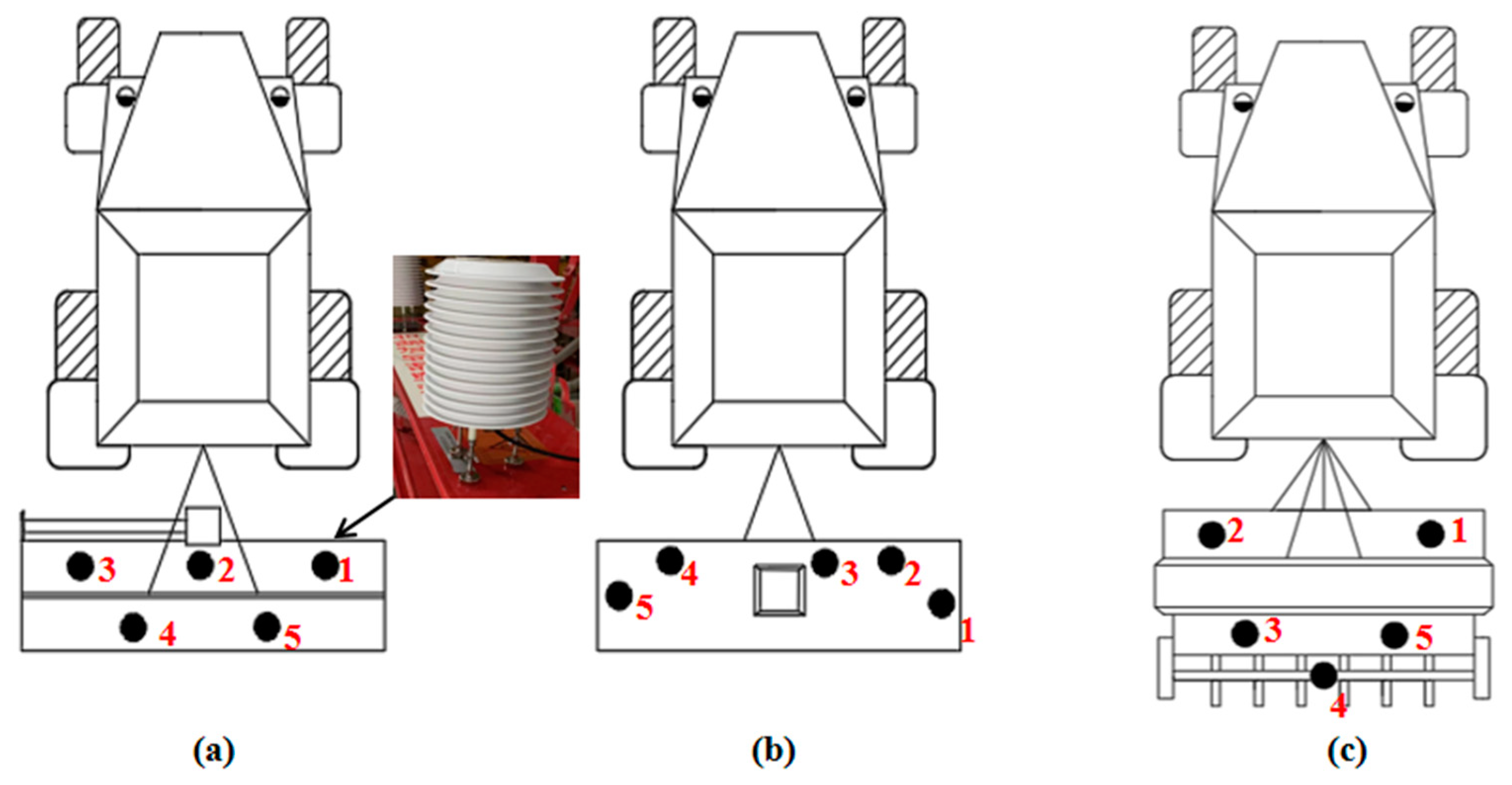

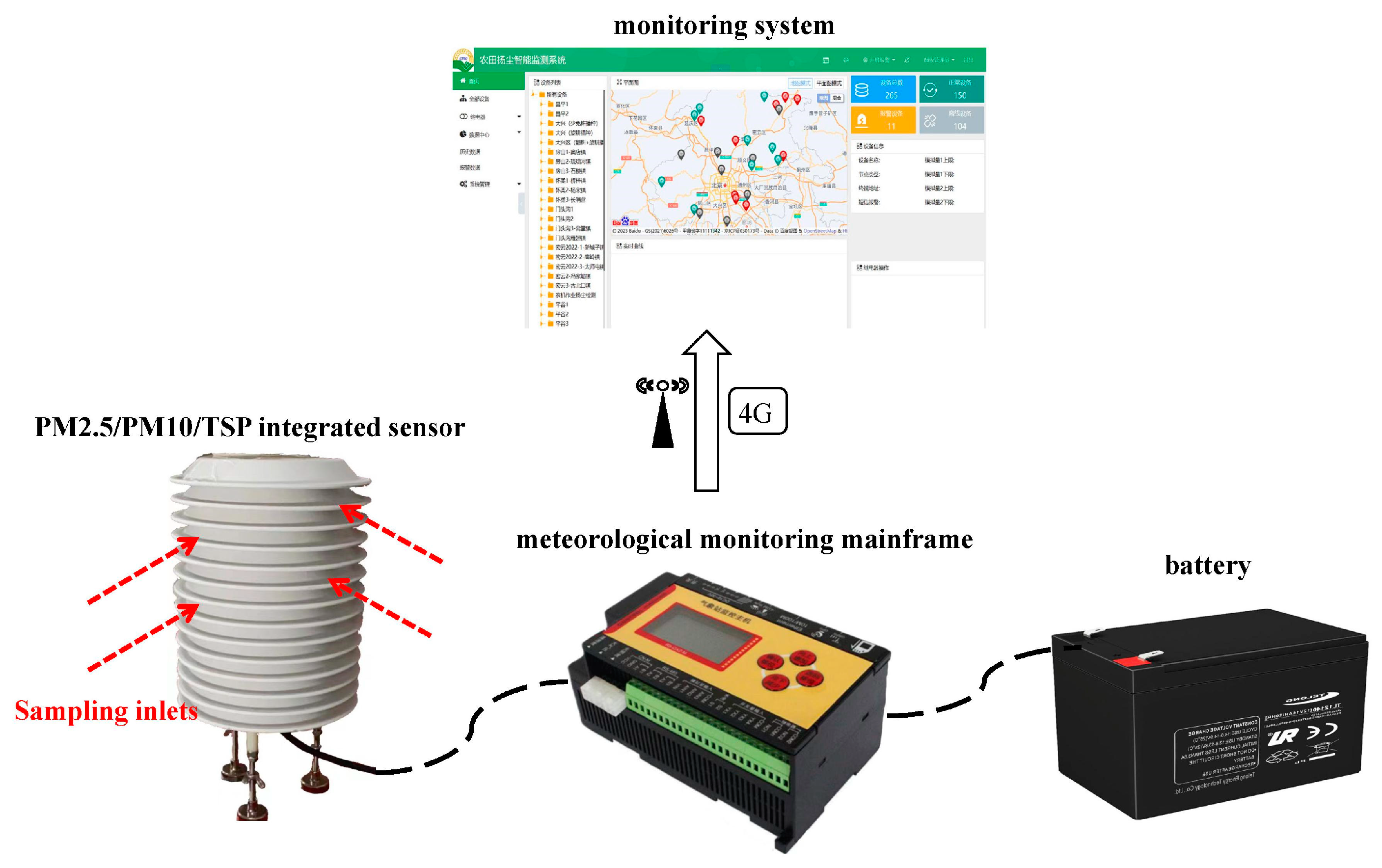
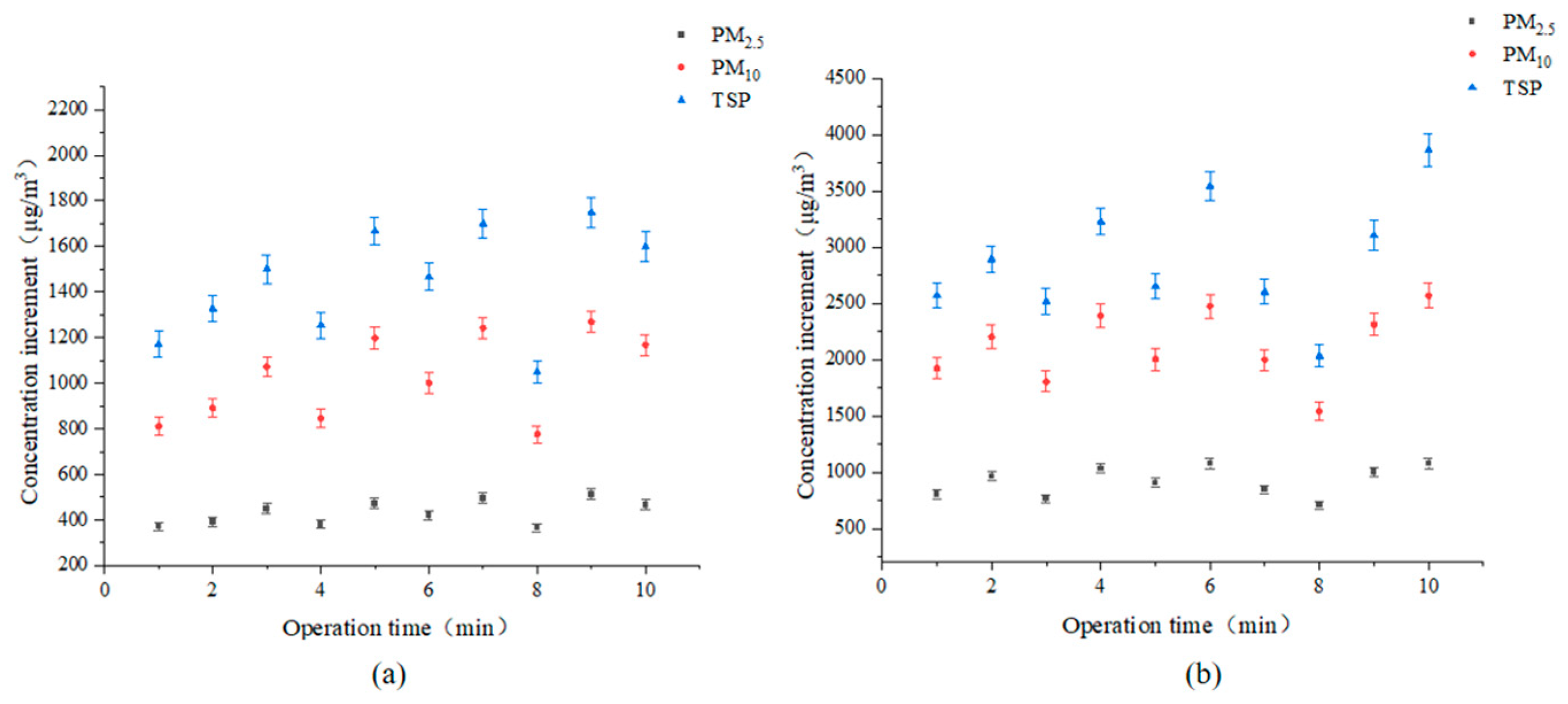


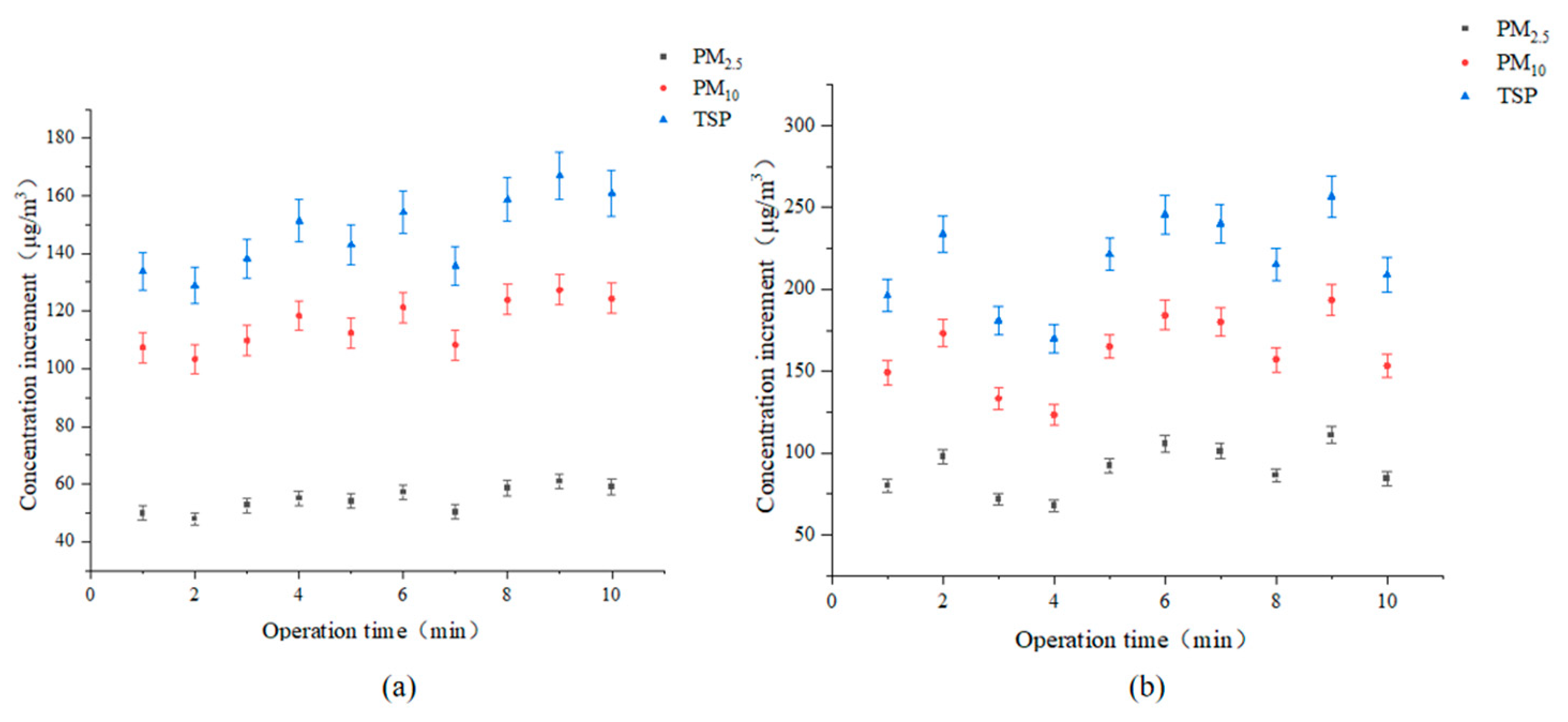
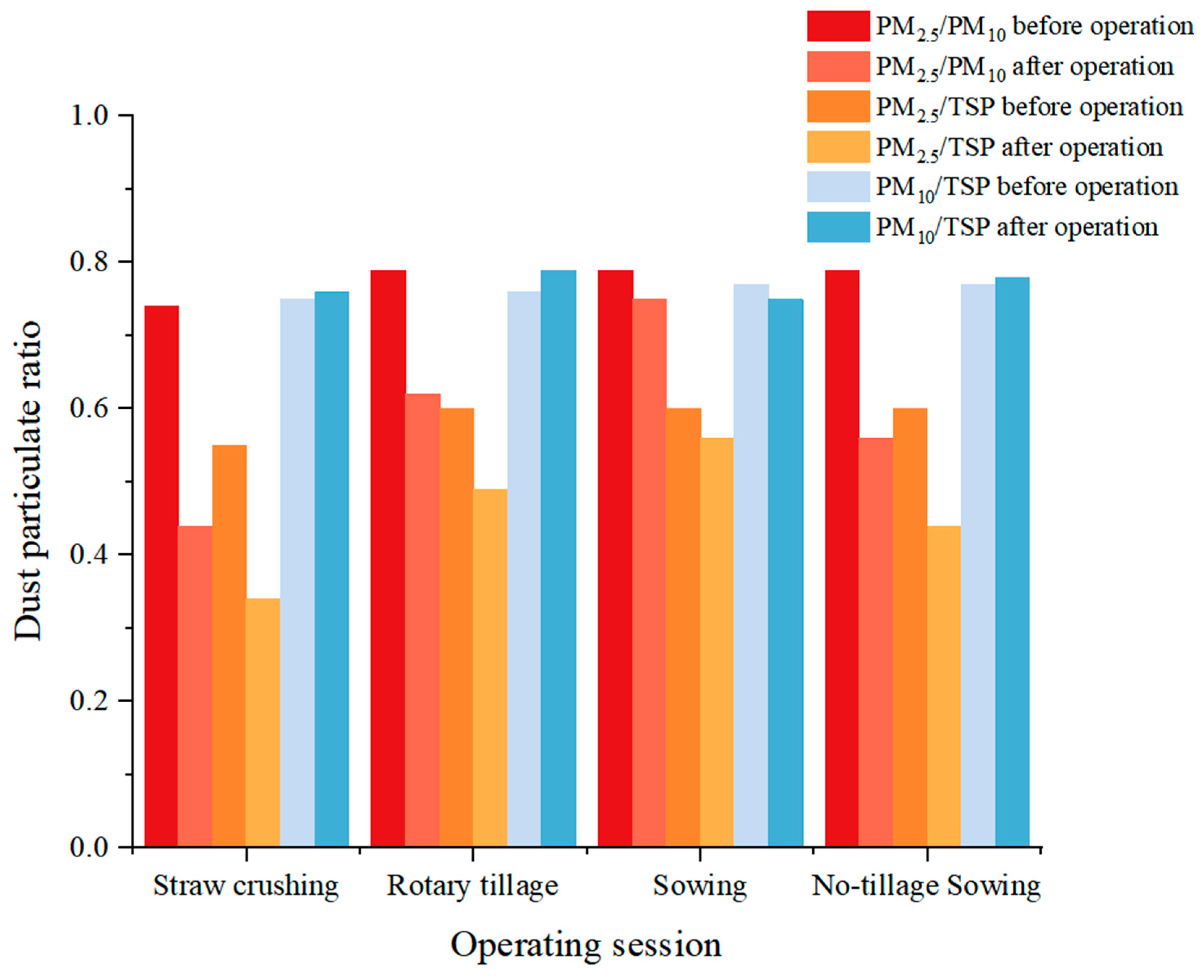
| Parameters | Value |
|---|---|
| Wind speed (m/s) | 1.2 ± 0.4 |
| Temperature (°C) | 22.3 ± 0.3 |
| Humidity (%RH) | 21.2 ± 0.2 |
| Atmospheric pressure (kpa) | 101.5 |
| Farming Pattern | Operation | Type of Dust | Environmental Value of Dust Concentration (Unit: μg/m3) | Dust Concentration after Each Operation (Unit: μg/m3) |
|---|---|---|---|---|
| Traditional tillage | Straw crushing | PM2.5 | 54.1 ± 3.2 | 494.3 ± 69.8 |
| PM10 | 73.3 ± 4.3 | 1121.6 ± 233.0 | ||
| TSP | 97.5 ± 5.7 | 1565.8 ± 392.7 | ||
| Rotary tilling | PM2.5 | 35.2 ± 4.2 | 119.3 ± 26.2 | |
| PM10 | 44.4 ± 6.5 | 192.1 ± 31.2 | ||
| TSP | 58.6 ± 8.5 | 241.9 ± 54.3 | ||
| Sowing | PM2.5 | 35.1 ± 4.4 | 46.1 ± 1.6 | |
| PM10 | 44.7 ± 6.3 | 61.3 ± 1.8 | ||
| TSP | 58.1 ± 8.7 | 82.3 ± 3.2 | ||
| Conservation tillage | No-tillage sowing | PM2.5 | 35.3 ± 4.4 | 89.5 ± 6.5 |
| PM10 | 45.1 ± 6.3 | 160.3 ± 12.0 | ||
| TSP | 58.6 ± 8.7 | 205.8 ± 19.0 |
| Operation | Incremental Dust Concentration | ||
|---|---|---|---|
| PM2.5 Increment (μg/m3) | PM10 Increment (μg/m3) | TSP Increment (μg/m3) | |
| Straw crushing | 440.2 ± 69.8 a | 1048.3 ± 233.0 b | 1468.3 ± 392.7 c |
| Rotary tilling | 84.1 ± 26.2 b | 147.7 ± 31.2 c | 183.3 ± 54.3 a |
| Sowing | 11.0 ± 1.6 c | 15.6 ± 1.8 a | 24.2 ± 3.2 b |
| No-tillage sowing | 54.2 ± 6.5 b | 115.2 ± 12.0 c | 147.2 ± 19.0 a |
| Farming Pattern | Operation | Quality of PM2.5 (g) | Quality of PM10 (g) | Quality of TSP (g) |
|---|---|---|---|---|
| Traditional tillage | Straw crushing | 1.096 ± 0.174 | 2.612 ± 0.581 | 3.415 ± 0.978 |
| Rotary tilling | 0.183 ± 0.058 | 0.389 ± 0.069 | 0.497 ± 0.121 | |
| Sowing | 0.036 ± 0.005 | 0.055 ± 0.006 | 0.078 ± 0.010 | |
| Total mass | 1.135 ± 0.183 | 3.056 ± 0.585 | 3.990 ± 0.985 | |
| Conservation tillage | No-tillage sowing | 0.187 ± 0.022 | 0.328 ± 0.040 | 0.407 ± 0.064 |
| Total mass | 0.187 ± 0.022 | 0.328 ± 0.040 | 0.407 ± 0.064 |
Disclaimer/Publisher’s Note: The statements, opinions and data contained in all publications are solely those of the individual author(s) and contributor(s) and not of MDPI and/or the editor(s). MDPI and/or the editor(s) disclaim responsibility for any injury to people or property resulting from any ideas, methods, instructions or products referred to in the content. |
© 2023 by the authors. Licensee MDPI, Basel, Switzerland. This article is an open access article distributed under the terms and conditions of the Creative Commons Attribution (CC BY) license (https://creativecommons.org/licenses/by/4.0/).
Share and Cite
Jia, L.; Zhou, X.; Wang, Q. Effects of Agricultural Machinery Operations on PM2.5, PM10 and TSP in Farmland under Different Tillage Patterns. Agriculture 2023, 13, 930. https://doi.org/10.3390/agriculture13050930
Jia L, Zhou X, Wang Q. Effects of Agricultural Machinery Operations on PM2.5, PM10 and TSP in Farmland under Different Tillage Patterns. Agriculture. 2023; 13(5):930. https://doi.org/10.3390/agriculture13050930
Chicago/Turabian StyleJia, Lin, Xiaoyi Zhou, and Qingjie Wang. 2023. "Effects of Agricultural Machinery Operations on PM2.5, PM10 and TSP in Farmland under Different Tillage Patterns" Agriculture 13, no. 5: 930. https://doi.org/10.3390/agriculture13050930
APA StyleJia, L., Zhou, X., & Wang, Q. (2023). Effects of Agricultural Machinery Operations on PM2.5, PM10 and TSP in Farmland under Different Tillage Patterns. Agriculture, 13(5), 930. https://doi.org/10.3390/agriculture13050930






